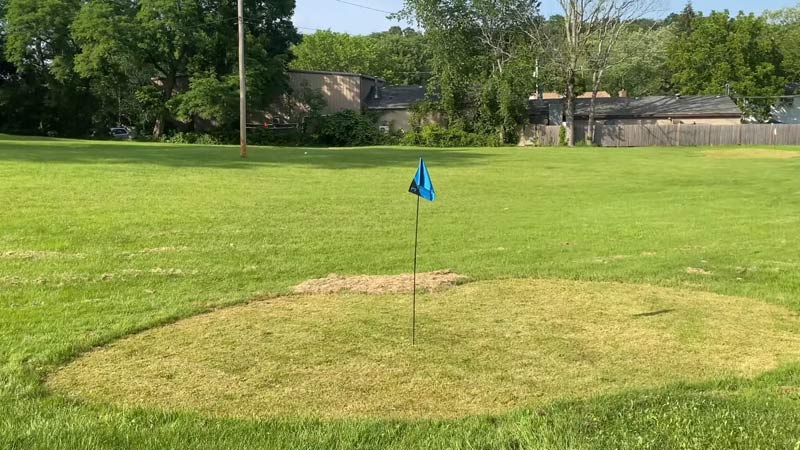Let’s join you on the journey to build a par 3 golf hole in your backyard and invite you to transform your outdoor space into a haven of leisure and skill.
Beyond the act of construction lies the promise of creating a unique, personalized golf experience at home.
Whether you’re an avid golfer seeking a new challenge or a homeowner yearning for a distinctive project, this comprehensive guide is your roadmap.
From meticulous planning to material selection, safety considerations, and maintenance insights, discover how to turn your backyard into a miniature golf oasis.
Join us on this adventure where each swing becomes a memory, and your backyard becomes a canvas for the joy, camaraderie, and satisfaction that come with building your very own par 3 haven.
Can I build a par 3 hole in my backyard?
Some people often get how to make a par 3 in their backyard when some don’t know whether they can finally build a par 3 in a backyard hole successfully or not.
Building a backyard par 3 hole in your backyard can be a fun and rewarding project, but there are several factors you should consider before getting started. Here are some key points to keep in mind:
Space and Layout
Ensure you have enough space for a par 3 hole. Consider the length of the hole, the surrounding landscape, and any potential safety concerns.
Plan the layout of the hole, taking into account natural features like trees, slopes, and existing structures.
Local Regulations
Check with your local municipality or homeowners’ association to determine if there are any zoning regulations or restrictions regarding the construction of a golf hole on your property.
Permits
Obtain any necessary permits before starting construction. This may include permits for landscaping, grading, or any other modifications to your property.
Safety
Ensure that the layout of the hole is safe for both players and bystanders. Consider the trajectory of golf balls and take precautions to prevent accidents.
Materials and Design
Choose suitable materials for the tee box, fairway, and green. Consider using synthetic turf for the putting surface, and plan for proper drainage to prevent waterlogging.
Maintenance
Be prepared for ongoing maintenance, including mowing, watering, and addressing any wear and tear on the course.
Budget
Establish a budget for the project, considering materials, permits, and any additional features you may want to include, such as bunkers or water hazards.
Water Conservation
Keep in mind the environmental impact of maintaining a golf course. Consider drought-resistant grass varieties and implement water-conservation practices.
Neighborhood Considerations
Be mindful of your neighbors. Noise from golf activities and the aesthetics of the course may impact them, so communicate your plans and address any concerns they may have.
Accessibility
Design the course to be accessible and enjoyable for players of different skill levels.
Remember that building a backyard golf hole requires careful planning and adherence to local regulations.
It can be a rewarding project for golf enthusiasts, but it’s important to approach it responsibly and consider the impact on your property and the surrounding community.
Planning Your Backyard Par 3
Certainly! Planning a par 3 backyard golf hole involves careful consideration of various factors to ensure a successful and enjoyable setup. Here are seven key points to consider
Space and Layout
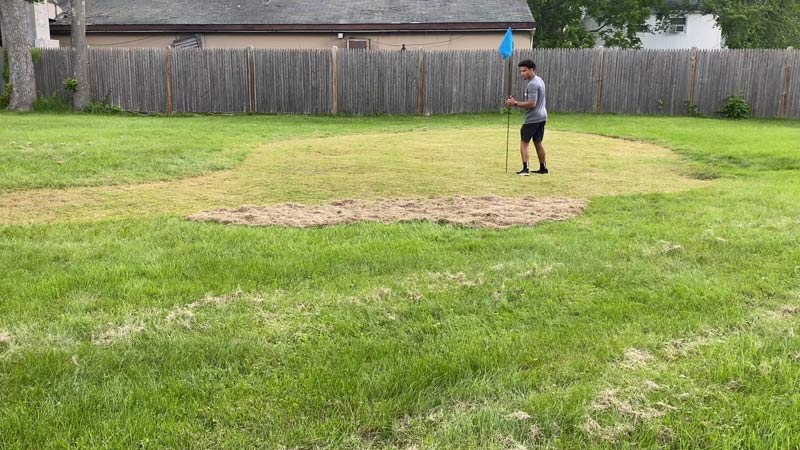
Before embarking on your project, carefully measure and evaluate the available space in your backyard.
Ensure that there is enough room for a tee box, fairway, and green. Take into account the length of the hole, considering both the distance and the layout of the landscape.
Work with the natural features of your backyard, such as slopes, trees, and other landscaping elements. Integrating these features can add both challenge and interest to your par 3 holes.
Regulations and Permits
Investigate local zoning regulations and any restrictions imposed by your homeowners’ association. Ensure that your plans comply with these regulations to avoid legal issues.
If required, obtain the necessary permits for landscaping, grading, or any other modifications to your property. This ensures that your project is officially sanctioned and adheres to safety and environmental standards.
Safety Precautions
Consider the trajectory of golf balls and plan the layout to minimize the risk of errant shots causing damage or injury. Position tee boxes and greens in locations that provide a safe playing environment.
If your backyard is close to neighboring properties, install safety nets or barriers to prevent golf balls from leaving your property and causing damage.
Materials and Design
Select appropriate materials for the tee box, fairway, and green. Synthetic turf is often a good choice for the putting surface, providing a consistent and low-maintenance option.
Incorporate proper drainage solutions to prevent waterlogging. This is crucial for maintaining a playable surface and preventing damage to the turf.
Maintenance Considerations
Develop a maintenance routine for mowing, watering, and general upkeep of the course. Regular care will ensure that the course remains in good condition and continues to be enjoyable for players.
Plan for addressing wear and tear on high-traffic areas, such as the putting green. Consider strategies to mitigate the impact of repeated ball impacts on the turf.
Budgeting
Determine a realistic budget for your backyard par 3 project. Consider the costs of materials, permits, and any additional features you may want to include, such as sand bunkers or landscaping elements.
Environmental Considerations
Select grass varieties that are well-suited to your climate and require minimal water. This promotes water conservation and helps create a sustainable backyard golf course.
Consider eco-friendly practices in your maintenance routine, such as using organic fertilizers and minimizing the use of chemicals.
By carefully addressing these points, you can plan and create a backyard par 3 golf hole that not only meets your vision but also adheres to local regulations and provides a safe and enjoyable experience for players.
Materials Needed to Built A backyard par 3 golf hole
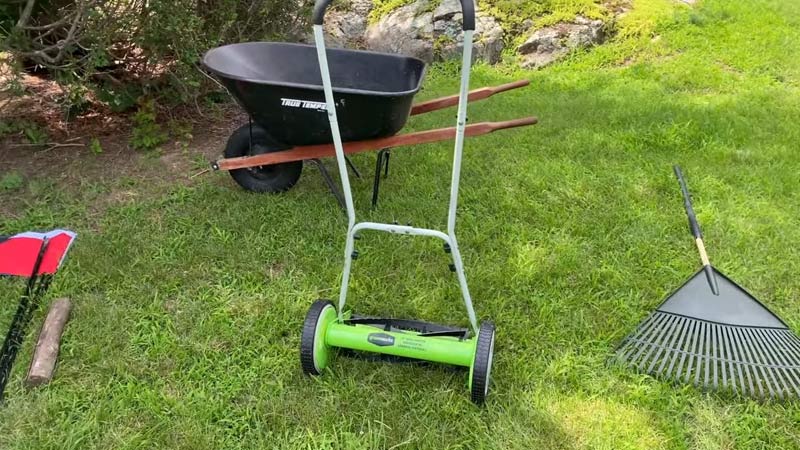
Building a backyard par 3 golf hole requires a variety of materials to create the tee box, fairway, and green. Here’s a list of materials you might need for the construction of a basic setup:
Backyard Tee Box
Grass or Synthetic Turf: Depending on your preference and climate, choose a grass variety suitable for a tee box or consider using high-quality synthetic turf for a low-maintenance option.
Fairway
Grass or Synthetic Turf: Extend the chosen turf material from the tee box into the fairway area. Again, select a grass variety or synthetic turf that suits your climate and maintenance preferences.
Putting Green
- Putting Surface: Use a specialized putting surface material, which could be a high-quality synthetic turf designed for putting greens. This material should provide a smooth and consistent putting experience.
- Cup and Flag: Purchase a regulation-sized cup and flag set for the putting green. This adds authenticity to your backyard golf hole.
Edging and Borders
- Edging Material: Install edging around the perimeter of the tee box, fairway, and green to define the boundaries. This could be landscape timbers, plastic edging, or other suitable materials.
- Mulch or Gravel: Use mulch or gravel as a transition material between the grass or turf and the edging to create a neat and visually appealing border.
Landscaping Materials
- Plants and Shrubs: Integrate landscaping elements around the golf hole for aesthetic appeal. Choose plants and shrubs that complement your backyard and don’t interfere with the playability of the course.
- Decorative Rocks or Features: Consider incorporating decorative rocks or other features to enhance the overall look of the golf hole.
Drainage Solutions
- Drainage Pipe or Gravel: Depending on your local climate and soil conditions, install drainage solutions such as perforated pipes or gravel to ensure proper water drainage from the playing surface.
Safety Features
- Safety Nets or Barriers: If your backyard is close to neighboring properties, install safety nets or barriers to prevent golf balls from leaving your property and causing damage.
- Warning Signs: Place warning signs to alert people to the presence of a golf hole and potential flying golf balls.
Maintenance Tools
- Lawn Mower: Keep the grass or synthetic turf at the desired height with a suitable lawn mower.
- Watering System: Install a watering system to maintain the health of the grass or turf.
- Golf Ball Retrieval Tools: Have tools on hand for retrieving golf balls from the cup or other areas.
Optional Features
- Sand Bunker: If you have space and want to add complexity to your golf hole, consider building a small sand bunker.
- Golf Tee Markers: Mark the tee box with golf tee markers to indicate different starting points.
Before purchasing materials, carefully plan the layout of your backyard par 3 golf hole and consider factors such as local regulations, safety, and maintenance requirements.
Adjust the list based on your specific vision for the golf hole and the characteristics of your backyard.
How to Build a Par 3 in Your Backyard
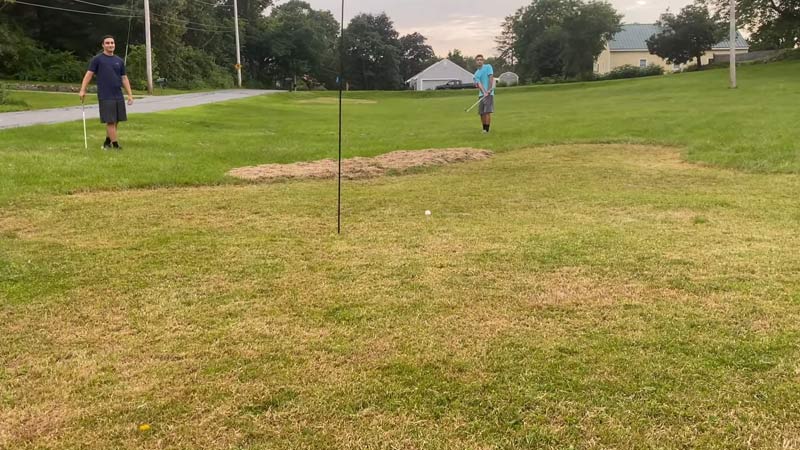
Building a par 3 golf hole in your backyard can be a rewarding project, providing a fun and recreational space for golf enthusiasts. Here’s a step-by-step guide to help you get started:
Planning
- Measure Your Space: Determine the available space for your par 3 hole. Consider the length, layout, and any natural features you want to incorporate.
- Design the Layout: Plan the tee box, fairway, and green. Take into account any slopes, trees, or other landscaping elements.
Research Local Regulations
Check Zoning and Regulations: Verify local zoning regulations and any restrictions from your homeowners’ association. Obtain the necessary permits for landscaping and construction.
Gather Materials
- Turf or Grass: Choose a suitable grass variety or synthetic turf for the tee box, fairway, and green.
- Edging Material: Select edging material to define the boundaries of the golf hole.
- Putting Green Surface: Acquire a specialized putting green surface for a smooth and consistent putting experience.
- Cup and Flag Set: Purchase a regulation-sized cup and flag for the putting green.
Prepare the Site
- Clear the Area: Remove any debris, rocks, or obstacles from the designated area.
- Grade the Land: Ensure a smooth and even surface by grading the land. Consider drainage needs during this process.
Build the Tee Box
- Lay the Turf: Install the chosen turf or grass for the tee box. Compact the soil underneath for a stable surface.
- Define Boundaries: Use edging material to define the tee box boundaries.
Construct the Fairway
Extend Turf: Continue the turf or grass into the fairway area. Incorporate Design Features: Integrate any design features you planned, such as slopes or landscaping.
Create the Putting Green
- Install Putting Surface: Lay down the specialized putting green surface on the designated green area.
- Add Cup and Flag: Install the cup in the center of the green and place the flag. Ensure it is level and properly secured.
Install Edging
Edge the Course: Use the chosen edging material to define the boundaries of the entire course, including the fairway and green.
Address Safety Concerns
- Install Safety Nets or Barriers: If necessary, set up safety nets or barriers to prevent golf balls from leaving your property.
- Place Warning Signs: Install signs to alert people to the presence of a golf hole and the potential for flying golf balls.
Landscaping and Finishing Touches
- Add Landscaping Elements: Integrate plants, shrubs, or decorative features to enhance the aesthetics of the golf hole.
- Mulch or Gravel: Use mulch or gravel as a transition material between the grass and the edging.
Maintain the Course
- Establish a Maintenance Routine: Develop a routine for mowing, watering, and general upkeep to keep the course in good condition.
- Address Wear and Tear: Monitor high-traffic areas and implement strategies to mitigate wear and tear.
Enjoy Your Backyard Par 3
Invite Friends and Family: Once your backyard par 3 is complete, invite friends and family to enjoy the space with you.
Remember to adapt these steps based on your specific backyard, preferences, and any unique challenges or features your property may have.
Building a backyard par 3 golf hole can be a creative and enjoyable project, providing hours of entertainment for golf enthusiasts of all skill levels.
Tips for DIY Par 3 Hole on Backyard
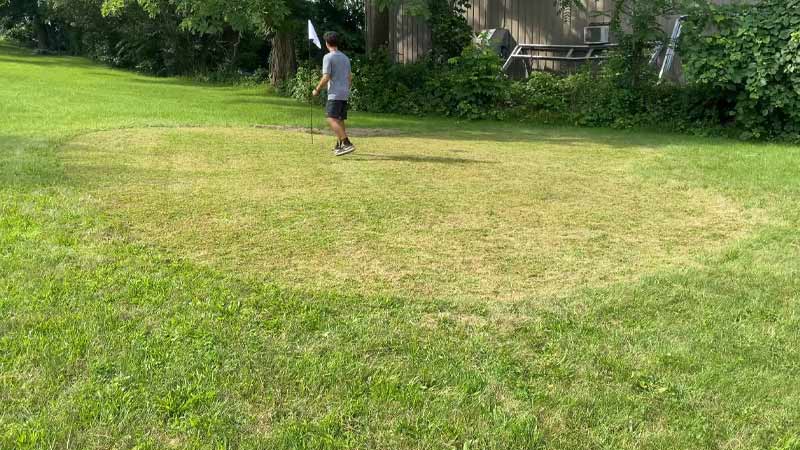
Creating a DIY par 3 hole in your backyard is an exciting project that can offer hours of enjoyment. Here are five detailed tips to guide you through the process:
1. Careful Planning and Design
- Measure and Assess Space: Begin by carefully measuring the available space in your backyard. Assess the dimensions to ensure you have adequate room for a tee box, fairway, and green.
- Consider Topography: Take note of any natural features, such as slopes or existing landscaping, and incorporate them into your design. These elements can add both visual interest and challenge to your par 3 hole.
- Sketch Your Layout: Create a detailed sketch of your backyard, marking the locations of the tee box, fairway, and green. Pay attention to the placement of trees, obstacles, and any planned landscaping elements.
- Plan for Safety: Factor in safety considerations, especially if your backyard is adjacent to neighboring properties. Ensure that the layout minimizes the risk of errant shots causing damage or injury.
2. Choose the Right Materials
- Select Turf or Grass Wisely: Choose a grass variety suitable for your climate and maintenance preferences, or opt for high-quality synthetic turf for a low-maintenance option. The putting green surface should be designed for smooth ball roll and durability.
- Quality Edging Material: Invest in durable edging material to define the boundaries of the tee box, fairway, and green. This not only enhances the appearance but also helps with maintenance and prevents the encroachment of grass into unwanted areas.
- Safety Nets or Barriers: If needed, select sturdy safety nets or barriers to contain golf balls within your property, especially if your backyard is close to neighbors.
3. Ensure Proper Drainage
- Assess Drainage Needs: Before laying down turf or grass, evaluate the drainage needs of your backyard. Poor drainage can lead to waterlogging and adversely affect the playing surface.
- Install Drainage Solutions: Incorporate drainage solutions such as perforated pipes or gravel to facilitate water drainage. This is crucial for maintaining a playable and healthy surface.
4. Consider Low-Maintenance Options
- Synthetic Turf for Putting Green: If you prefer a low-maintenance solution, consider using synthetic turf for the putting green. It provides a consistent playing surface and requires minimal upkeep.
- Drought-Resistant Grass Varieties: Choose grass varieties that are well-suited to your local climate and require less water. This not only conserves water but also reduces maintenance efforts.
5. Safety Measures and Neighbor Considerations
- Install Safety Signage: Clearly mark the presence of a golf hole with signage, indicating potential flying golf balls. This is especially important if your backyard is near pedestrian areas or other homes.
- Communicate with Neighbors: Before and during the construction process, communicate your plans with neighbors. Address any concerns they may have and proactively implement safety measures to minimize disruptions.
- Time Your Golf Activities: Be mindful of the timing of your golf activities, considering your neighbors’ schedules and local noise ordinances.
By carefully following these tips, you can ensure that your DIY par 3 hole is not only a fun addition to your backyard but also a safe and enjoyable space for you and your neighbors.
FAQs
Can I build a par 3 hole in a small backyard?
Yes, it’s possible to build a par 3 hole in a small backyard. Opt for a compact design, consider synthetic turf for space efficiency, and focus on short distances.
Strategic planning allows you to create an enjoyable golf experience even in limited space.
Do I need special permits to build a backyard par 3?
It depends on your local regulations. Check with your municipality and homeowners’ association to determine if permits are required.
Obtaining the necessary permits ensures that your project complies with safety and environmental standards.
What type of grass is best for a backyard par 3?
Choose grass varieties suitable for your climate and maintenance preferences. Bermuda grass and bentgrass are popular for putting greens. Synthetic turf is an alternative for low-maintenance options, providing a consistent playing surface.
How can I ensure the safety of neighbors and passersby?
Install safety nets or barriers to contain golf balls within your property. Additionally, place warning signs indicating the presence of a golf hole and potential flying golf balls.
Communicate with neighbors to address any concerns they may have.
How do I maintain a backyard par 3 golf hole?
Establish a regular maintenance routine, including mowing, watering, and addressing wear and tear. Consider eco-friendly practices, choose drought-resistant grass, and monitor the condition of the course.
Proactive maintenance ensures a consistently enjoyable playing surface.
Wrapping Up
Building a par 3 in your backyard is not merely about constructing a golf hole; it’s about crafting an experience.
Through careful planning, material selection, and consideration of safety measures, you’ve transformed your outdoor space into a haven for golf enthusiasts.
As you take that final swing on your new green, surrounded by the fruits of your labor, remember that this project is more than a physical structure—it’s a canvas for memories and a testament to your dedication.
Embrace the joy it brings, share it with loved ones, and savor the satisfaction of creating a personal golf retreat right at home.
Your backyard par 3 is not just a course; it’s a journey, a source of pride, and a constant invitation for enjoyment and relaxation. May your putts be true, and your backyard adventures be filled with the spirit of the game.

